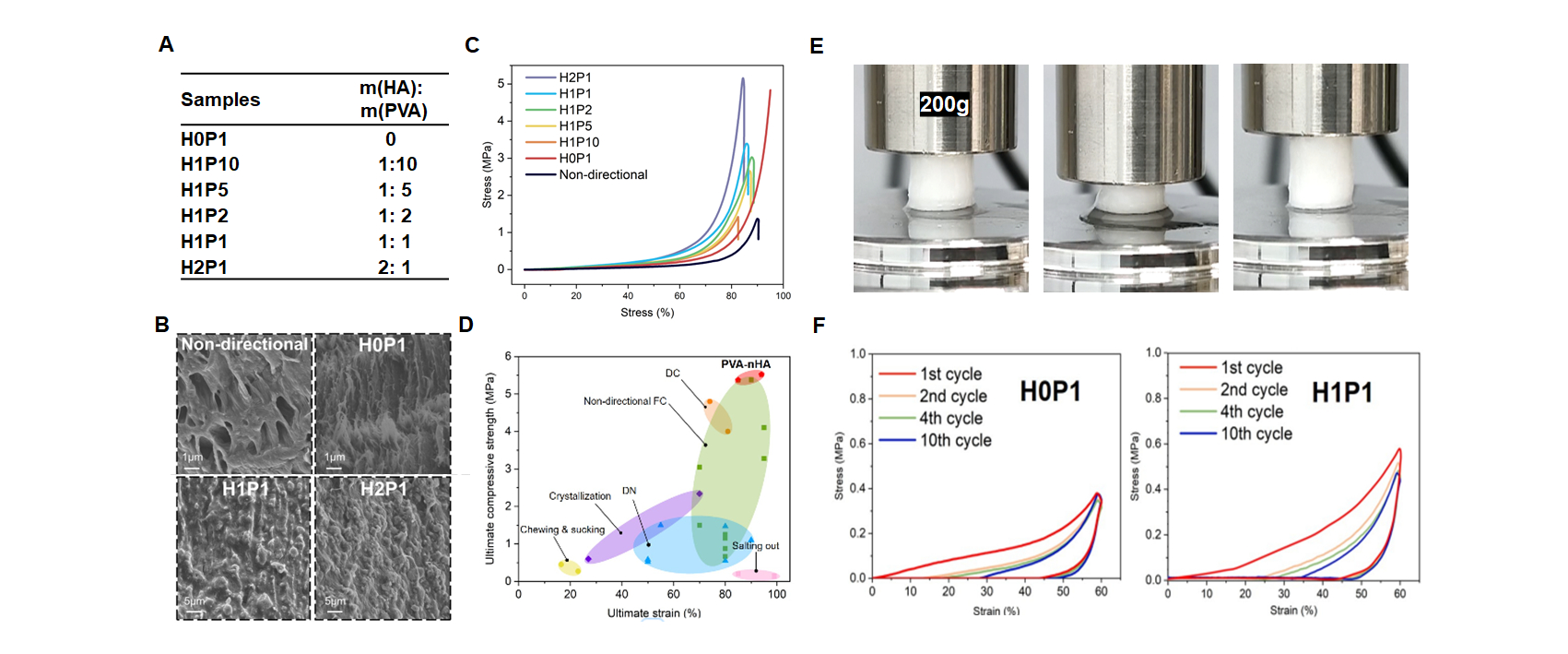IADR Abstract Archives
Super Tough Hydrogel With Nano-Hydroxyapatite for Alveolar Bone Regeneration
Objectives: Alveolar bone deficiencies pose significant challenges in dental surgery. Traditional grafting materials, such as hydroxyapatite (HA), tricalcium phosphate ceramics (TCP), and bioactive glasses (BAG), provide good osteointegrative and osteoconductive properties but face structural and mechanical limitations. This study aims to develop a highly resilient polyvinyl alcohol/nano-hydroxyapatite (PVA/nHA) hydrogel using directional freezing and salting out, offering enhanced toughness, resilience, and osteoconductive properties.
Methods: A 5 wt% PVA solution was mixed with nano-HA at various mass ratios and directionally frozen by vertical immersion in liquid nitrogen at 10mm/min, followed by salting out in a pre-cooled 1.5M sodium citrate solution. After preparation, samples were longitudinally sectioned and freeze-dried for surface morphology analysis using scanning electron microscopy (SEM). Mechanical properties were evaluated through compression tests at 2mm/min, and resilience was assessed using cyclic loading tests at a strain of 60%.
Results: Tough PVA/nHA hydrogels with various proportions of PVA and nHA were successfully prepared (Figure 1A). SEM showed that non-directional freezing resulted in hydrogels with random and loosely porous microstructures, while directional freezing produced a highly ordered arrangement (Figure 1B). As nHA concentration increased, pores became more filled, improving the hydrogel's mechanical properties. Compression tests and cyclic loading tests confirmed this, revealing increased ultimate stress, toughness, and energy dissipation density with higher nHA proportions (Figure 1C, 1E, Table 1). However, the enhanced mechanical property was offset by the faster degradation of energy dissipation after 10 cycles of loading (Figure 1F, Table 1). The developed hydrogel exhibited the highest ultimate stress compared to other tough materials and significantly higher than the force in chewing and sucking (Figure 1D).
Conclusions: Super tough PVA-nHA hydrogels, featuring enhanced toughness and resilience, were successfully fabricated. These properties position them as a promising alternative for bone grafting materials with significant potential in bone regeneration applications.
Methods: A 5 wt% PVA solution was mixed with nano-HA at various mass ratios and directionally frozen by vertical immersion in liquid nitrogen at 10mm/min, followed by salting out in a pre-cooled 1.5M sodium citrate solution. After preparation, samples were longitudinally sectioned and freeze-dried for surface morphology analysis using scanning electron microscopy (SEM). Mechanical properties were evaluated through compression tests at 2mm/min, and resilience was assessed using cyclic loading tests at a strain of 60%.
Results: Tough PVA/nHA hydrogels with various proportions of PVA and nHA were successfully prepared (Figure 1A). SEM showed that non-directional freezing resulted in hydrogels with random and loosely porous microstructures, while directional freezing produced a highly ordered arrangement (Figure 1B). As nHA concentration increased, pores became more filled, improving the hydrogel's mechanical properties. Compression tests and cyclic loading tests confirmed this, revealing increased ultimate stress, toughness, and energy dissipation density with higher nHA proportions (Figure 1C, 1E, Table 1). However, the enhanced mechanical property was offset by the faster degradation of energy dissipation after 10 cycles of loading (Figure 1F, Table 1). The developed hydrogel exhibited the highest ultimate stress compared to other tough materials and significantly higher than the force in chewing and sucking (Figure 1D).
Conclusions: Super tough PVA-nHA hydrogels, featuring enhanced toughness and resilience, were successfully fabricated. These properties position them as a promising alternative for bone grafting materials with significant potential in bone regeneration applications.

